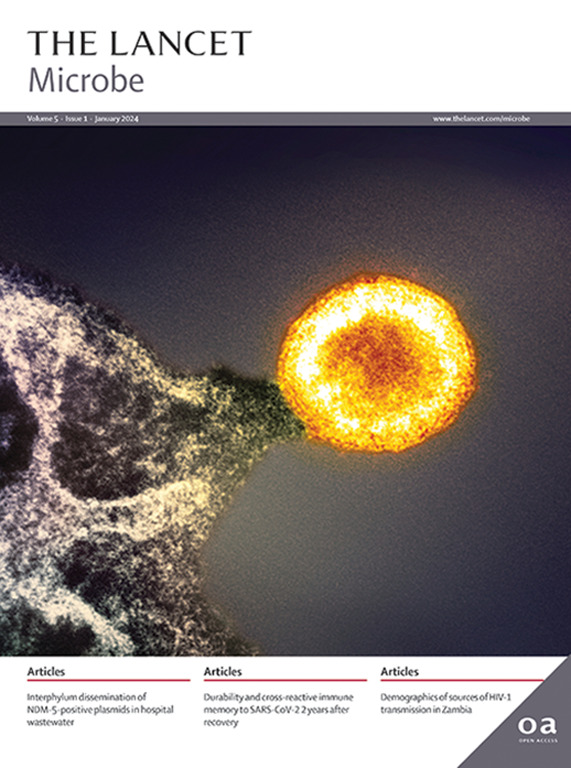Investigation of associations between the neonatal gut microbiota and severe viral lower respiratory tract infections in the first 2 years of life: a birth cohort study with metagenomics
IF 20.4
1区 生物学
Q1 INFECTIOUS DISEASES
引用次数: 0
Abstract
Background
Early-life gut microbiota affects immune system development, including the lung immune response (gut–lung axis). We aimed to investigate whether gut microbiota composition in neonates in the first week of life is associated with hospital admissions for viral lower respiratory tract infections (vLRTIs).
Methods
The Baby Biome Study (BBS) is a prospective birth cohort, which enrolled mother–baby pairs between Jan 1, 2016, and Dec 31, 2017, at three UK hospitals. In the present study, we only included BBS babies with a sequenced first-week stool sample and successful data linkage. Stool was collected in the first week of life for shotgun-metagenomic sequencing. We examined the following microbiota features: alpha diversity (Chao1, Shannon, and Simpson indices) and community structures (cluster-partitioning against medoids method). The participants were followed up through linkage to the Hospital Episode Statistics-Admitted Patient Care (HES-APC) database to determine vLRTI hospital admission incidence in the first 2 years of life. We used Poisson mixed-effects models for univariable and multivariable analyses to evaluate the association between microbiota features and vLRTI hospital admission incidence, adjusting for confounders identified through direct acyclic graphs.
Findings
3305 (95%) of the 3476 BBS-enrolled babies for whom consent to data linkage was obtained were included in the present study. 1111 (34%) babies had a first-week sequenced stool sample, of whom 1082 (97%; 564 born vaginally and 518 born by caesarean section) were successfully linked to HES-APC, and had median follow-up of 2·0 years (IQR 1·4–2·9). Most babies were born at term (996 [92%] ≥37 weeks gestational age and 1070 [99%] >35 weeks gestational age) and healthy (1050 [97%] had no comorbidities), and 520 (48%) were female and 562 (52%) were male. Higher first-week gut microbiota alpha diversity was associated with reduced rates of vLRTI hospital admission (Chao1 Index adjusted hazard ratio [HR] 0·92 [95% CI 0·85–0·99]; Shannon Index adjusted HR 0·57 [0·33–0·98]; and Simpson Index adjusted HR 0·36 [0·11–1·20]). Three microbiota clusters were identified. Cluster 1 had a mixed composition and cluster 2 was dominated by Bifidobacterium breve, with both clusters observed in babies born vaginally and by caesarean section. Cluster 3 was found only in vaginally born babies and was dominated by Bifidobacterium longum. Having cluster 1 (mixed) or cluster 2 (B breve dominated) was independently associated with increased rates of vLRTI hospital admission compared with cluster 3 (B longum dominated; cluster 1 [mixed] 3·05 [1·25–7·41] and cluster 2 [B breve dominated] 2·80 [1·06–7·44]).
Interpretation
We report observational evidence that first-week gut microbiota differences are associated with clinically severe vLRTI in young children. This study identified bacterial species that could be of interest for vLRTI prevention. This finding has important implications for the design of future research and intervention strategies.
Funding
The Wellcome Trust and Wellcome Sanger Institute core funding.
新生儿肠道菌群与2岁前严重病毒性下呼吸道感染之间关系的研究:一项宏基因组学出生队列研究
背景:早期肠道微生物群影响免疫系统发育,包括肺免疫反应(肠-肺轴)。我们的目的是调查新生儿在出生后第一周肠道微生物群组成是否与病毒性下呼吸道感染(vLRTIs)住院有关。方法:婴儿生物群落研究(BBS)是一项前瞻性出生队列研究,于2016年1月1日至2017年12月31日在英国三家医院招募母婴对。在本研究中,我们只纳入了具有第一周粪便样本测序和成功数据链接的BBS婴儿。在出生后第一周收集粪便进行散弹宏基因组测序。我们研究了以下微生物群特征:α多样性(Chao1、Shannon和Simpson指数)和群落结构(针对介质的聚类划分法)。通过连接医院事件统计-入院患者护理(HES-APC)数据库对参与者进行随访,以确定生命前2年的vLRTI住院发生率。我们使用泊松混合效应模型进行单变量和多变量分析,以评估微生物群特征与vLRTI住院发生率之间的关系,并对通过直接无环图确定的混杂因素进行调整。结果:3476名在bbs注册的婴儿中,有3305名(95%)被纳入本研究,这些婴儿同意进行数据链接。1111例(34%)婴儿有第一周的粪便样本测序,其中1082例(97%;564例顺产出生,518例剖宫产出生)成功联系HES-APC,中位随访时间为2.0年(IQR为1.4 ~ 1.9)。大多数婴儿足月出生(996例[92%]≥37周胎龄,1070例[99%]≥35周胎龄)且健康(1050例[97%]无合并症),女性520例(48%),男性562例(52%)。较高的第一周肠道菌群α多样性与vLRTI住院率降低相关(Chao1指数校正风险比[HR] 0.92 [95% CI 0.85 - 0.99];Shannon指数调整后的HR为0.57 [0.33 - 0.98];Simpson指数调整后的HR为0.36[0.11 - 1.20])。鉴定出三个微生物群。聚类1混合组成,聚类2以短双歧杆菌为主,在顺产和剖腹产出生的婴儿中都观察到这两个聚类。集群3仅在顺产婴儿中发现,以长双歧杆菌为主。与聚类3(长B型为主)相比,聚类1(混合型)或聚类2(短B型为主)与vLRTI住院率增加独立相关;聚类1[混合型]3.05[1.25 - 7.41],聚类2 [B型]2.80[1.06 - 7.44])。解释:我们报告了观察性证据,第一周肠道微生物群差异与幼儿临床严重vLRTI相关。本研究确定了可能对vLRTI预防感兴趣的细菌种类。这一发现对未来研究和干预策略的设计具有重要意义。资助:惠康信托基金和惠康桑格研究所核心资助。
本文章由计算机程序翻译,如有差异,请以英文原文为准。
求助全文
约1分钟内获得全文
求助全文
来源期刊

Lancet Microbe
Multiple-
CiteScore
27.20
自引率
0.80%
发文量
278
审稿时长
6 weeks
期刊介绍:
The Lancet Microbe is a gold open access journal committed to publishing content relevant to clinical microbiologists worldwide, with a focus on studies that advance clinical understanding, challenge the status quo, and advocate change in health policy.
 求助内容:
求助内容: 应助结果提醒方式:
应助结果提醒方式:


